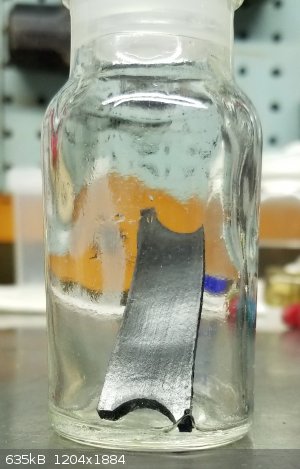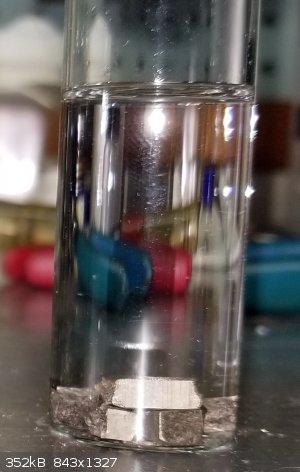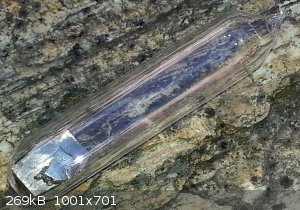
Dan Vizine - 16-12-2019 at 14:12
While it's widely known that nitric acid is useful for the removal of the black coating of oxide that forms on uranium metal exposed to air, exactly
what concentration of acid is best to use and what, if any, additives are beneficial were pieces of data that I lacked. I searched on SM for "cleaning
uranium" expecting to find multiple entries, but this simplistic search returned no relevant hits. By looking through a few of the many AEC monographs
downloadable from this site, I found an optimized cleaning mixture that utilizes diluted acid and incorporates hydrogen peroxide in the mixture.
The ratio of choice for the components 70% HNO3, distilled H2O and 30% H2O2 was given as 49 to 49 to 2 (parts by volume). Given that I have immediate
access to 3% H2O2 and no easy access to 30% H2O2, an equivalent solution was prepared using 70% HNO3, distilled H2O and 3% H2O2 in a 49 to 31 to 20
volume ratio. For all practical purposes, this can be prepared in the laboratory by mixing:
1) 5 volumes of 70% HNO3
2) 3 volumes of distilled H2O
3) 2 volumes of 3% H2O2
Uranium metal is often packaged under mineral oil or with at least a mineral oil coating. Mineral oil is supposedly soluble in toluene, and it very
likely is when pure and anhydrous, but all of the mineral oil that I find coating some reactive metals seems to contain some small toluene-insoluble
fraction, maybe a few percent. I suspect that it may commonly be water. The first step in cleaning the metal is to totally remove the oil. Several
washes with toluene removed the obvious oily coating. The metal was then washed a couple of times with acetone to remove the suspected moisture and
then blotted dry.
A blackened sample of U is shown in one of the accompanying pictures. I had another 18+ grams of similar-looking metal as a half dozen small chunks.
They were solvent washed as described above and then added to a 10 mL lot of the acid-peroxide solution. The solution liberated small bubbles (and
thus is suited for outdoor or fume hood work lest any aerosolized U enter the air) and the solution slowly assumed a color reminiscent of dinitrogen
tetroxide. The color may also be from solubilized oxide and no attempt to decide which one was actually responsible was made. After 5 minutes, with
occasional gentle stirring, the metal faces which were smooth were etched to a flat to moderately shiny silver color. Areas of the metal which
presented fractured surfaces were also cleaned by the etchant but more slowly. For many presentational purposes, the metal can then be rinsed with
water followed by acetone, then dried under a stream of argon and sealed into an ampoule under vacuum or argon. The second picture shows what the
sample looks like at this point.
To achieve even nicer surfaces on samples with appropriate surface morphology, scrubbing underwater with a mild abrasive such as SiC impregnated
polymer mesh pad or by using a simple abrasive cleanser, like Comet may be performed. The metal may be further subjected to gentle cleaning with a
small stainless steel wire wheel mounted in a Dremel tool if desired. This requires protection for the operator by employing a rudimentary glovebox or
similar isolation scheme because of the radioactive dust that it generates. A 9-gram sample ultimately cleaned by this method is pictured below in an
ampoule under argon.
The spent acid solution may be diluted with water and adjusted to a pH of 11 - 12 with ammonia. This causes the concentration of dissolved U to
decrease by about 4 orders of magnitude and the resulting precipitate may be collected by filtration and packaged with your other low level insoluble
radioactive wastes for appropriate disposal.



[Edited on 12/17/2019 by Dan Vizine]
stamasd - 18-12-2019 at 14:16
Excellent! This requires a thorough peer review including exact reproduction in an independent lab. I volunteer, but I need a piece of uranium for
that. 
(edited to say: 30% H2O2, or more precisely 27% H2O2 is easily available from pool supply shops; usually you have to buy it in bulk. I got 4 gallons
for about $60 including shipping, brand name "Baquacil oxidizer")
[Edited on 18-12-2019 by stamasd]
Dan Vizine - 18-12-2019 at 14:29
Ohhh...thanks for that bit of OTC knowledge. Previously I only knew of beauty shops as potential sources.
G-Coupled - 18-12-2019 at 17:17
What concentration H2O2 are beauty suppliers allowed to/will sell to private customers?
Dan Vizine - 18-12-2019 at 19:05
It seems that's irrelevant now. A company named Lab Alley sells 30% H2O2 for $27/L. I just never realized that it had become so easy to get.
fusso - 20-12-2019 at 21:16
May I ask where did u get that piece of beautiful U metal?
Dan Vizine - 21-12-2019 at 18:39
Hi Fusso,
It belongs to a client. I don't really know its source.

